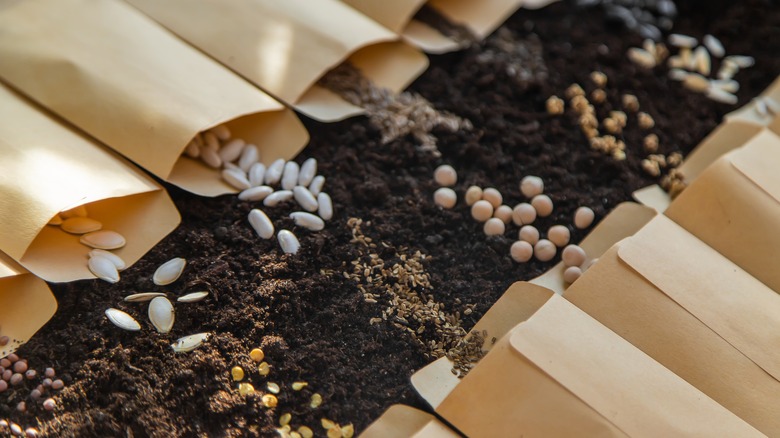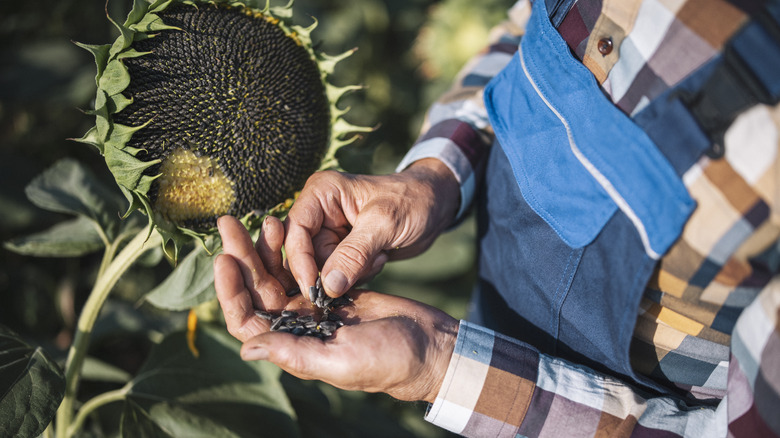Do Garden Seeds Expire? Yes And No
Society is used to expiration dates. You have a couple of weeks for milk, several months for items in the fridge, and potentially years for highly processed foods stored on shelves. But if the food we eat has dates, what about their seed form? You may have heard conflicting information about whether seeds expire, and the hard evidence isn't any less confusing. How can there be a Guinness world record for a 2,000-year-old seed successfully germinating while a pack of seeds you bought two years ago gives you nothing? The success of your seeds depends on the quality of their storage, but different types of seeds have different lengths of viability.
Results vary, but generally speaking, the longest-lasting seeds are tomatoes, celery, beets, and Brassicas with five years of viability. Legumes, corn, okra, carrots, peppers, squash, and basil will last two to four years, and onions, spinach, and parsley will only last one year. However, storage is everything. You can increase a seed's chance of being viable beyond its basic rate by storing it well and taking the time to germinate it with great care.
How to make seeds last longer
The key factor to keeping a seed viable is proper storage, which means you need to make sure your seed doesn't hold too little or too much moisture. Not holding too much moisture is sensible; seeds turn moldy or sprout if they sit in water or humidity. But too little? Seeds can actually become too dry to germinate — these are called hard seeds. Hard seeds have less than 8% moisture, and although they're difficult to germinate, they also have a better chance of surviving 10 years or more.
To save seeds with the right amount of moisture, harvest them after they have fully dried on the plant, or remove them from the plant, clean them, and let them sit and dry for a couple of weeks in a warm, dry space. They should be dry to the touch when they're ready. For hard seeds, let them sit in a 100-degree Fahrenheit oven for six hours while ensuring that the oven never gets any hotter.
Once your seeds are sufficiently dry, store them in a glass container or paper envelopes. Never use plastic bags, as those can harbor moisture and risk growing mold. Keep your seeds cool and dry, and periodically check for moisture. The "100 rule" is good to go by; the temperature and humidity level should equal 100 or less. So, 60 degrees Fahrenheit allows for up to 40 percent humidity.
Using a germination test to determine viability
If you're worried about a pack of seeds' viability, you can always test the package. From Dream to Seed on TikTok has an easy tutorial to follow. She takes 10 seeds from each packet and places them on a damp paper towel. Then, she puts them in a plastic bag and leaves them in a warm place for up to 10 days. After waiting, she checks for sprouted seeds. The number of sprouted seeds represents the percentage of viability in the packet. If only four out of 10 seeds sprout, you can assume only 40 percent of the entire package will sprout.
This test can be used for any seed, whether it's a small flower seed or a large vegetable seed. If you want to make economic choices in the garden, testing all your seed packets during winter while you wait to plant your spring garden is a good way to determine if you should buy more seeds or not. If a packet has a low germination rate, you'll likely need to plant all the seeds for a good outcome. However, if there's a high germination rate, you don't have to plant all of them, and you may be able to use them again next year, but keep in mind that viability decreases each year.

